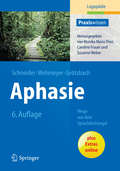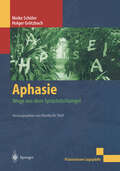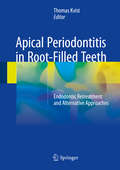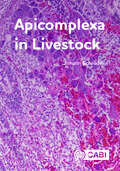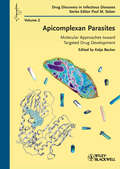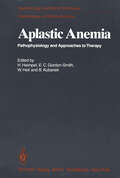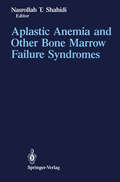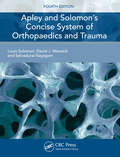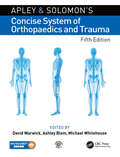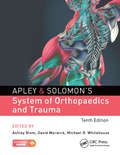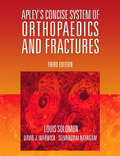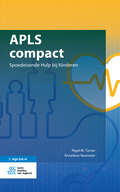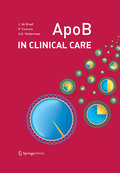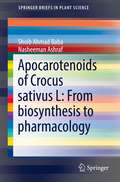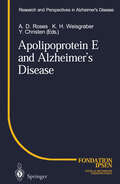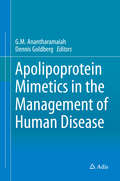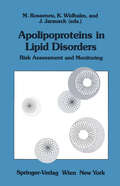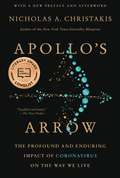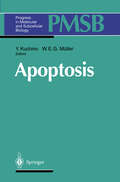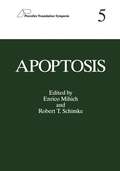- Table View
- List View
Aphasie: Wege aus dem Sprachdschungel (Praxiswissen Logopädie)
by Barbara Schneider Meike Wehmeyer Holger GrötzbachPlötzlich sprachlos sein …… heißt für viele Patienten mit Aphasie, in einem „Dschungel“ aus Buchstaben, Wörtern und Sätzen sich zurechtfinden zu müssen. Welche Wege können Sie als Sprachtherapeut gemeinsam mit Ihren Patienten einschlagen, um sie aus diesem Dickicht zu führen, damit eine Teilhabe an Gesprächen und am sozialen Leben wieder möglich ist?Dieses erfolgreiche Lehrbuch – inzwischen in der 6. Auflage – vermittelt Ihnen die einzelnen Schritte dieses Weges in einer ausgewogenen Mischung aus Hintergrund- und Praxisinformationen. Sie erhalten alle für die Therapien erforderlichen Kenntnisse über Symptome und Syndrome, Anamnese und Diagnostik, Planung und Durchführung der Behandlung. Unterschiedliche Therapiebausteine unterstützen Sie dabei, für jede Störung individuell angepasste Übungen mit „Regieanweisungen“ durchzuführen, Hilfestellungen zu leisten und Materialempfehlungen umzusetzen.NEU in der 6. AuflageLangzeitverlauf von Aphasie bei Kindern und JugendlichenNeue ScreeningverfahrenEinsatz von PCs und TabletsKommunikativ orientierte Aphasietherapie
Aphasie: Wege aus dem Sprachdschungel (Praxiswissen Logopädie)
by Meike Wehmeyer Holger GrötzbachDas Buch führt verständlich und ganz an der Praxis orientiert in Grundlagen, Diagnose und Behandlung von Aphasien ein. Es beschreibt ausführlich das diagnostische Vorgehen und leitet zu Planung und Durchführung von Therapien an. Der große Fundus an therapeutischen Übungen ist weitgehend mit "Regieanweisungen", Hinweisen zu Hilfestellungen und Materialempfehlungen versehen, damit wird die Umsetzung in den therapeutischen Alltag leicht gemacht. Die methodisch-didaktischen Therapieanregungen orientieren sich an der individuellen Symptomatik und an den Anforderungen der alltäglichen Kommunikation. Neben therapeutischen Ansätzen in den Bereichen Alexie und Agraphie wird erstmals ausführlich auf die Akalkulie eingegangen. Auch die Themen Krankheitsverarbeitung und Angehörigenberatung werden aufgegriffen. Die Erfahrungsberichte eines Betroffenen und einer Angehörigen unterstreichen die Notwendigkeit einer ganzheitlichen Behandlung von Aphasien.
Apical Periodontitis in Root-Filled Teeth: Endodontic Retreatment and Alternative Approaches
by Thomas KvistThis book is a comprehensive guide to apical periodontitis in root-filled teeth that covers not only all aspects of diagnosis and management but also epidemiology, etiology, consequences, clinical decision-making, and prognosis. There is a particular focus on the available surgical and nonsurgical methods of retreatment designed to restore healthy periapical conditions. Alternatives to retreatment are also explored, including a conservative approach involving monitoring of the diseased tooth without intervention and the option of extraction and replacement with an implant or a fixed prosthesis.The goal of root canal treatment is to save the natural tooth even when tissue breakdown has resulted in pathological conditions of the pulp and periradicular tissue. However, population studies reveal that complete healing is often absent in root-filled teeth, and apical periodontitis is frequently observed in conjunction with root fillings of poor technical quality. Under these circumstances, questions arise as to how the apical periodontitis is impacting on the patient and how the condition should be tackled. Readers will find this well-illustrated book to be of great value in directing clinical practice.
Apicomplexa in Livestock
by Johann SchröderThe Apicomplexa is a globally prevalent group of parasitic protozoa that cause disease, from malaria in humans to livestock diseases such as coccidiosis, babesiosis (Red Water, Tick Fever) and East Coast Fever. With significant economic impacts, a number of Apicomplexa are also zoonotic, leading to grave potential public health consequences. Infection prevention efforts by immunisation or management of arthropod vector infestation have not been universally successful, and can have knock-on effects such as pollution of the environment and human food chain, and development of insecticidal or acaricidal resistance. This book highlights the similarities and differences between the various Apicomplexa infections, identifying those of greatest significance and suggesting sustainable approaches to better manage their impact on livestock productivity. The book: Reviews Australian livestock as a case study, but highlights global applications, biosecurity concerns and lessons learned; Covers Apicomplexa-caused disease across cattle, pigs, poultry and sheep; Considers human health and environmental impacts, and how sustainable management methods can better outcomes for all. Suitable for researchers and students of veterinary parasitology and related disciplines, this book is a valuable resource covering this important set of parasites.
Apicomplexan Parasites: Molecular Approaches toward Targeted Drug Development (Drug Discovery in Infectious Diseases)
by Paul M. SelzerThis handbook is the first dealing with the discovery of drugs directed against apicomplexan parasites. Amongst others, this group of endoparasites includes the causative agents of Malaria, Toxoplasmosis, and Babesiosis, the latter occurring mainly in animals. Written by renowned scientific experts from academia and industry, the book focuses on currentdrug development approaches for all apicomplexan diseases making it appealing to a large audience, ranging from research labs in academia to the human and veterinarian pharmaceutical industry. This work is the second volume of the new book series 'Drug Discovery in Infectious Diseases', edited by Prof. Dr Paul M. Selzer.
Apicomplexan Parasites: Molecular Approaches toward Targeted Drug Development (Drug Discovery in Infectious Diseases #2)
by Paul M. SelzerThis handbook is the first dealing with the discovery of drugs directed against apicomplexan parasites. Amongst others, this group of endoparasites includes the causative agents of Malaria, Toxoplasmosis, and Babesiosis, the latter occurring mainly in animals. Written by renowned scientific experts from academia and industry, the book focuses on currentdrug development approaches for all apicomplexan diseases making it appealing to a large audience, ranging from research labs in academia to the human and veterinarian pharmaceutical industry. This work is the second volume of the new book series 'Drug Discovery in Infectious Diseases', edited by Prof. Dr Paul M. Selzer.
Aplastic Anemia: Pathophysiology and Approaches to Therapy (Haematology and Blood Transfusion Hämatologie und Bluttransfusion #24)
by Hermann Heimpel, Edward C. Gordon-Smith, Wolfgang Heit and Bernhard KubanekResearch on aplastic anaemia has until recently been limited to clinical description, morphology and epidemiology. New methods to culture haemopoietic cells, and advances in our knowledge of proliferation and differentiation in the haemopoietic cell system .opened a new area of scientific interest for this "prototype" of haemopoietic failure. In addition, bone marrow transplantation became not only a clinical method of treatment, but also a source of data useful for the discussion of pathophysiological models of aplastic anaemia. This situation prompted us to arrange an international con ference on aplastic anaemia, with particular emphasis on its patho physiology and the rationals of the current therapeutic approaches. This conference was held at Schloss Reisensburg from July 20-22, 1978 with the participation of both experimental and clinical scientists active in this field or in related areas of research. The proceedings of the symposion reflect the present knowledge as well as the many new questions which arose from the discussions. The editors are gratefully indebted to the participants of this meeting, to Gerlinde Trogele and all the co-workers of the Uni versity of Ulm engaged in preparation of this symposium and of this volume, and last not least to all sponsors who provided the financial basis for this scientific event.
Aplastic Anemia and Other Bone Marrow Failure Syndromes
by Nasrollah T. ShahidiDuring the past decade, there have been numerous direct and indirect scientific contributions to both the etiology and therapy of aplastic anemia and related bone marrow failure syndromes. Clinical observations, such as autologous bone marrow recovery after conditioning with immunosup pressive agents for bone marrow transplantation; failure to achieve en graftment in some identical twins without prior immunosuppressive ther apy; and hematologic response to immunosuppressive agents, have led to the concept of immune-mediated etiology of acquired aplastic anemia. Such a concept was further strengthened by laboratory findings, implicat ing the role of activated cytotoxic T lymphocytes and abnormal produc tion of inhibitory lymphokines. The immunologic mechanisms may also apply to the idiosyncratic bone marrow aplasias associated with drugs, toxic chemicals, and viruses. These agents may alter normal cellular recog nition sites by interacting with cellular components and result in loss of self tolerance. Immunologic mechanisms have long been advocated in many other organ failures, and the hemopoietic organ is no exception. It is of interest that parallel clinical and laboratory investigations in juvenile diabetes mellitus type I and in rodent models of this disease have yielded results compatible with the same pathogenic mechanisms. The infiltration of pancreatic islets by activated T lymphocytes, functional and morphological alterations of islet cells upon incubation with lymphokines such as gamma interferon and tumor necrosis factor, and clinical response to cyclosporine are a few examples.
Apley and Solomon's Concise System of Orthopaedics and Trauma
by Louis Solomon David J. Warwick David Warwick Selvadurai Nayagam Salvadurai NayagamApley and Solomon's Concise System of Orthopaedics and Trauma is firmly established as the leading introductory textbook of orthopaedic practice and the principles of fracture management. Praised in previous editions for its systematic approach, balanced content and easy-to-read style, the fourth edition has been brought fully up to date with more
Apley and Solomon’s Concise System of Orthopaedics and Trauma
by David Warwick Ashley Blom Michael WhitehouseApley & Solomon's Concise System of Orthopaedics and Trauma is firmly established as the leading introductory textbook of orthopaedic practice and the principles of fracture and trauma management. Praised in previous editions for the systematic approach, balanced content and easy-to-read style, this fifth edition has been brought fully up to date under the direction of the new and distinguished authorial team, while remaining true to the teaching principles of Alan Apley and his successor Louis Solomon. Key features: Focused – on diseases and clinical signs with additional detail on anatomy where appropriate International – enhanced coverage of 'global orthopaedics' reflect the changing pattern of musculoskeletal disease and trauma around the world Relevant – provides helpful guidance on simple procedures without unnecessary operative detail Readable – increased emphasis on concise presentation Current – updates reflect developments in molecular biology, genetics and imaging technology This fifth edition remains the first choice for medical students, trainee surgeons and other health professionals seeking a convenient introduction to this large and complex subject and is a natural precursor to the more detailed coverage offered by its larger parent, Apley & Solomon's System of Orthopaedics and Trauma.
Apley and Solomon’s Concise System of Orthopaedics and Trauma
by David Warwick Ashley Blom Michael Whitehouse Richard GardnerApley & Solomon's Concise System of Orthopaedics and Trauma is firmly established as the leading introductory textbook of orthopaedic practice and the principles of fracture and trauma management. Praised in previous editions for the systematic approach, balanced content and easy-to-read style, this fifth edition has been brought fully up to date under the direction of the new and distinguished authorial team, while remaining true to the teaching principles of Alan Apley and his successor Louis Solomon. Key features: Focused – on diseases and clinical signs with additional detail on anatomy where appropriate International – enhanced coverage of 'global orthopaedics' reflect the changing pattern of musculoskeletal disease and trauma around the world Relevant – provides helpful guidance on simple procedures without unnecessary operative detail Readable – increased emphasis on concise presentation Current – updates reflect developments in molecular biology, genetics and imaging technology This fifth edition remains the first choice for medical students, trainee surgeons and other health professionals seeking a convenient introduction to this large and complex subject and is a natural precursor to the more detailed coverage offered by its larger parent, Apley & Solomon's System of Orthopaedics and Trauma.
Apley & Solomon�s System of Orthopaedics and Trauma
by Ashley Blom David Warwick Michael WhitehouseNow in its Tenth Edition and in continuous publication since 1959, Apley & Solomon's System of Orthopaedics and Trauma is one of the world's leading textbooks of orthopaedic surgery. Relied upon by generations of orthopaedic trainees the book remains true to the teaching principles of the late Alan Apley and his successor Professor Louis Solomon. This new edition is fully revised and updated under the leadership of new editors. It retains the familiar 'Apley' philosophy and structure, and is divided into three major sections: General Orthopaedics, Regional Orthopaedics and Trauma, thus enabling readers to gain the knowledge they need for their lifetime learning.
Apley & Solomon's System of Orthopaedics and Trauma
by Ashley Blom David Warwick Michael WhitehouseNow in its Tenth Edition and in continuous publication since 1959, Apley & Solomon's System of Orthopaedics and Trauma is one of the world's leading textbooks of orthopaedic surgery. Relied upon by generations of orthopaedic trainees the book remains true to the teaching principles of the late Alan Apley and his successor Professor Louis Solomon. This new edition is fully revised and updated under the leadership of new editors. It retains the familiar 'Apley' philosophy and structure, and is divided into three major sections: General Orthopaedics, Regional Orthopaedics and Trauma, thus enabling readers to gain the knowledge they need for their lifetime learning.
Apley's Concise System of Orthopaedics and Fractures
by Louis Solomon David J. Warwick Salvadurai NayagamThis leading introductory textbook of orthopaedics provides medical students, trainee surgeons and other health professionals with an invaluable overview of this important specialty. Praised in previous editions for the systematic approach, balanced content and easy-to-read style, the new edition has been brought fully up to date, with additional d
APLS compact: Spoedeisende Hulp bij Kinderen
by Nigel M. Turner Anneliese NusmeierDit boek biedt artsen en andere professionals een eenvoudige en effectieve methodiek voor de spoedeisende geneeskunde bij kinderen. Het helpt bij het zetten van de juiste eerste stappen bij de acute opvang van ernstig zieke of zwaargewonde kinderen. Informatie is visueel en tekstueel zo vormgegeven dat er snelle kennisoverdracht plaatsvindt.APLS compact is voor een groot deel afgeleid van het toonaangevende leerboek Advanced Paediatric Life Support: de Nederlandse editie. Het is een hulpmiddel bij acute situaties, zoals benauwdheid, shock, verminderd bewustzijn, convulsies, elektrolyten- en metabole stoornissen, traumaopvang en kindermishandeling. Het boek is specifiek voor de Nederlandse praktijk geschreven. Daarbij zijn landelijke richtlijnen en protocollen gebruikt, die gemaakt of onderschreven zijn door de Nederlandse wetenschappelijke verenigingen. U vindt in het boek verwijzingen naar websites met de meest actuele richtlijnen en adviezen. Er is ook een epub verkrijgbaar waarmee u het boek online kan raadplegen op bijvoorbeeld uw telefoon. APLS compact is geschreven door verschillende kinderartsen en -chirurgen. De hoofdredactie bestaat uit dr. Nigel Turner, kindercardioanesthesioloog in het Wilhelmina Kinderziekenhuis en onderwijskundige in het UMC Utrecht, en dr. Anneliese Nusmeier, kinderarts-intensivist in het Radboudumc Nijmegen
ApoB in Clinical Care
by Jacqueline de Graaf Patrick Couture Allan SnidermanNow, based on the apoB algorithm, that is outlined and illustrated in this book, family physicians as well as cardiologists, endocrinologists and internists will be able to easily and accurately identify and treat these disorders.The apoB dyslipoproteinemias are major common causes of vascular disease. But until now, accurate diagnosis has not been possible. With just total cholesterol, triglycerides and apoB, all the apoB dyslipoproteinemias, with the exception of elevated Lp(a), can be identified using the apoB algorithm. The apoB app, which incorporates this algorithm, is available from both Apple and Android and is free.
Apocarotenoids of Crocus sativus L: From biosynthesis to pharmacology (SpringerBriefs in Plant Science)
by Shoib Ahmad Baba Nasheeman AshrafThis book is a product of years of research on saffron biology. It intends to give a broad but concise overview of the various aspects of apocarotenoid biosynthesis in Crocus sativus, its regulation and pharmacology .Crocus sativus L. of family Iridaceae is an important medicinal plant. The dried stigma of C. sativus flower is considered as the world's costliest spice. Saffron is the sources of unique carotenoid derived molecules called apocarotenoids which include crocin, crocetin, picrocrocin and safranal. These molecules are synthesized in the tissue and developmental stage specific manner. Besides providing colour, aroma and flavour to the spice, these molecules have tremendous medicinal importance. The book uncovers major concepts of apocarotenoids biosynthesis and provides deeper and more complete understanding about their biotechnological and pharmacological applications.The book is divided into three sections –The first section provides a general introduction of C. sativus, its apocarotenoids, their biosynthesis, regulation and transport. Second section provides information about the carotenoid cleavage dioxygenases (CCDs) which are the key players in apocarotenoid biosynthesis. The classification of plant CCDs, their structure, reaction mechanism, biotechnological application are thoroughly discussed. The final section deals with the major pharmacological properties of C. sativus apocarotenoids, ranging from their role as anticancer to their utility as neuroprotective molecules.This is a one of its kind book on Crocus sativus. It will be useful for the researchers working on Crocus sativus, students and also practitioners involved in extraction and bio-synthesis of the useful medical components.
Apolipoprotein E and Alzheimer’s Disease (Research and Perspectives in Alzheimer's Disease)
by A. D. Roses K. H. Weisgraber Y. ChristenApolipoprotein Mimetics in the Management of Human Disease
by G. M. Anantharamaiah Dennis GoldbergThis comprehensive book provides not only the stages in the development of this unique and specialized field but also updates on the current state of research and development of apolipoprotein mimetics as therapeutic modalities for various lipid-mediated disorders. The book consists of 11 chapters all written by leading scientists from well-reputed laboratories in the USA. After an introduction by Dr. Godfrey Getz, Professor of Medicine at the University of Chicago and the Associate Editor of the Journal Lipid Research, the book presents a narration of how a theory can lead to the discovery of treatment modalities to several devastating diseases such as diabetes, Alzheimer’s disease, arthritis; asthma; atherosclerosis, chronic rejection of transplanted hearts and cancer.Present therapies for most of these diseases are not adequate. Using the models of two long anti-atherogenic and anti-inflammatory proteins (apolipoprotein A-I and apolipoprotein E with 243 and 299 amino acids, respectively) short mimetic peptides of 18 to 28 amino acid residues in length, which can be produced either synthetically or genetically in edible fruits and vegetables, have been shown to exert profound biological effects in a large number of animal models of diseases.The book also presents novel ideas, highly unexpected mechanisms of action in animal models and even in initial clinical studies in humans, which can lead to additional improvements in basic and clinical research in biological science. All the chapters are written by experts in their respective fields who have contributed immensely to the literature. This is the first compendium of this growing field presented in the form of a book.
Apolipoproteins in Lipid Disorders: Risk Assessment and Monitoring
by Maryvonne Rosseneu Kurt Widhalm Jochen JarauschThere is increasing evidence for the clinicial value of the apo lipoprotein measurements. Besides cholesterol in plasma and li poprotein fractions, which is currently used as an indicator of cardiovascular risk, the measurement of the AI and B apolipopro teins can provide additional information about the patients' clinical status. Several studies show that apo B is higher and apo AI is lower in patients with angiographically documented coronary heart dis ease than in symptomatic patients without coronary heart disease. Moreover, discriminant analysis indicated that the concentration of Apo AI and B in plasma are better discriminators than lipo protein cholesterol for identifying patients with coronary heart disease. In some studies the apo Bjapo AI ratio appears to be a more powerful predictor than individual lipoproteins. In a recent study carried out in men, apolipoproteins AI and B were better correlated with the severity of cardiovascular disease than HDL and LDL cholesterol. The predictive power of apolipoproteins could however not be demonstrated in all studies and the value of apolipoprotein measurements in the field of clinical chemistry is still controversial. This is probably due to discrepancies between the results of various studies, arising from differences in the type of immunoassays, the lack of universal reference materials, differ ences between study protocols, variations in the selection of patients and in the grading and interpretation of coronary lesions.
Apollo's Arrow: The Profound and Enduring Impact of Coronavirus on the Way We Live
by Nicholas A. ChristakisA piercing and scientifically grounded look at the emergence of the coronavirus pandemic and how it will change the way we live — "this year's must-must-read." (Daniel Gilbert) Apollo's Arrow offers a riveting account of the impact of the coronavirus pandemic as it swept through American society in 2020, and of how the recovery will unfold in the coming years. Drawing on momentous (yet dimly remembered) historical epidemics, contemporary analyses, and cutting-edge research from a range of scientific disciplines, bestselling author, physician, sociologist, and public health expert Nicholas A. Christakis explores what it means to live in a time of plague — an experience that is paradoxically uncommon to the vast majority of humans who are alive, yet deeply fundamental to our species. Unleashing new divisions in our society as well as opportunities for cooperation, this 21st-century pandemic has upended our lives in ways that will test, but not vanquish, our already frayed collective culture. Featuring new, provocative arguments and vivid examples ranging across medicine, history, sociology, epidemiology, data science, and genetics, Apollo's Arrow envisions what happens when the great force of a deadly germ meets the enduring reality of our evolved social nature.
Apollo's Arrow: The Profound and Enduring Impact of Coronavirus on the Way We Live
by Nicholas A. ChristakisA piercing and scientifically grounded look at the emergence of the coronavirus pandemic and how it will change the way we live — "excellent and timely." (The New Yorker) Apollo's Arrow offers a riveting account of the impact of the coronavirus pandemic as it swept through American society in 2020, and of how the recovery will unfold in the coming years. Drawing on momentous (yet dimly remembered) historical epidemics, contemporary analyses, and cutting-edge research from a range of scientific disciplines, bestselling author, physician, sociologist, and public health expert Nicholas A. Christakis explores what it means to live in a time of plague — an experience that is paradoxically uncommon to the vast majority of humans who are alive, yet deeply fundamental to our species.Unleashing new divisions in our society as well as opportunities for cooperation, this 21st-century pandemic has upended our lives in ways that will test, but not vanquish, our already frayed collective culture. Featuring new, provocative arguments and vivid examples ranging across medicine, history, sociology, epidemiology, data science, and genetics, Apollo's Arrow envisions what happens when the great force of a deadly germ meets the enduring reality of our evolved social nature.
Apoptosis (Progress in Molecular and Subcellular Biology #16)
by Y. Kuchino W. E. G. MüllerApoptosis plays a central role in the regulation of cell proliferation. Disruption of this control mechanism may cause serious human diseases such as encephalomyelitis and cancer. Thus, understanding of the molecular mechanisms of apoptotic cell death should lead to fundamental advances in the therapy of these diseases.
Apoptosis (Pezcoller Foundation Symposia #5)
by Enrico Mihich Robert T. SchimkeThe fifth Annual Pezcoller Symposium entitled, Apoptosis, was held in Trento, Italy, June 9-1I, 1993 and was focused on the specific phenomena leading to Programmed Cell Death (PCD) or Apoptosis, and the mechanisms involved. With presentations at the cutting edge of progress and stimulating discussions, this Symposium addressed the genetics and molecular mechanisms determining PCD and the role of this suicidal process in cancer and the immune system. The functions of pS3, c myc and bel 2 in affecting apoptosis in different cell types and the role of ions and intracellular pH changes and that of intranuelear endonueleases are given particular emphasis as are the effects of anticancer agents, hormone imbalances and growth factors. The role of pS3, a tumor suppressor gene, in inducing PCD is discussed in detail as pertinent to hematological and non-hernatological tumors. The requirement of pS3 for the induction ofapoptosis by ionizing radiation or adenovirus oncoproteins is outlined. Decision points during the cell cyele affecting the cascade ofevents leading to PCD are discussed as is their role as "switches" under the control of c-myc and bel-2 proteins or the influence of cyele specific drugs. The concurrent requirement of multiple signals in determining apoptosis is emphasized. The examples of the role of PCD in the regulation of hematopoiesis, and in the generation of antigen-specific immune repertoire are illustrated.
